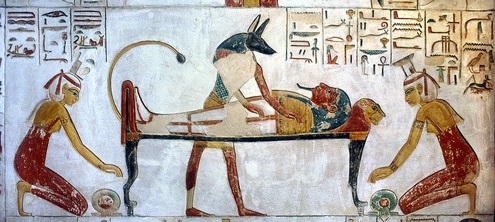
Fragment of Papyrus of Hornefer. Ptolemaic Period. Museo Castello Sforzesco in Milan.Castello Photo: www.ancient.eu.com
Position of charaters in Ancient Egypt art is more important than we could think, because it could also hide some intentions.
The hieroglyph over the kneeling mourner in this image from the papyrus of Hornefer is not clear at all, so we cannot read her name, but thanks to her position next to the coffin, we can know she is Nephtys.
The two mourners who took care of the mummy (so the two Drty), where during the Ancient Egypt funerals the representatives of Isis and Nephtys. Those two mourning women and the two goddesses were usually represented in the same way: they accompanied the body at both extremes of the coffin, Isis at the feet of the corpse and Nephtys at the head. The point is why?

Isis and Nephtys at both extremes of the corpse with shen rings. Tomb of Siptah. XIX Dynasty. Valley of the Kings. Photo: www.thethebanmappingproject.com
We all know that in Ancient Egypt the artist had to follow the canon, not just from the aesthetic point of view (color of skins, perspective…), but also the whole composition was subjected to some rules, like the order of some scenes, what they could represent or not, or the position of some characters.
In almost all images of Isis and Nephtys with the mummy, the Egyptian artists represented them always as we described above. If this was a rule, it had to have a sense, because in Ancient Egypt art for art’s sake did not exist.

Two different ways of representing Isis and Nephtys assisting the deceased: as the two kites (tomb of Sennedjem) and as women (tomb of Nakhtamon). XIX Dynasty. Photos: http://www.osirisnet.net
As we are in a funerary context, the explanation has to be related to the role of these two women as mourners in the funeral of Ancient Egypt. We need to look at the mourning ritual they made for contributing to the deceased’s resurrection. It was a re-enactment of the myth of Osiris and in it there were two main aspects which give sense to the position of Isis at the feet of the dead. One of these aspects is sex.

Mummy with both mourners on the extreme making the nwn gesture. Funerary temple of Seti I in Dra Abu el-Naga. Photos: Mª Rosa Valdesogo Martín
The two women in the role of Isis and Nephtys, shook their hair forwards the mummy, among other things, for reproducing the episode in which Isis put on Osiris’ phallus for giving him back his virility and conceives Horus. This intercourse would be dramatized in the mourning rite in its most human version, which is why the mourner shook her hair forwards the mummy, as if she, as a woman, would be over her husband’s body.

Isis as a kite over the corpse of Osiris. Relief from the temple of Seti I in Abydos. XIX Dynasty. Photo: www.commons.wikimedia.org
Usually Egyptian artists represented that coitus with Isis as a kite facing her husband Osiris and over the phallus of the mummy. When the Egyptian artist had to represent Isis as the woman and wife, the one who has sex with her husband over him and facing him, the most logical position next Osiris would be at his feet.
So, maybe Isis appears at the feet of Osiris because from there she will copulate with him.
But we have said “two main aspects”, sex is one, do you imagine which the other one is?
